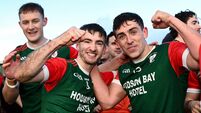Eimear Ryan: After Shane Lowry, could celebrity sponsorship become a welcome trend in Ireland?

2019 Open Champion Shane Lowry announced recently he will sponsor Offaly GAA focussing on grassroots development.
It was heartening to hear the news that the garlanded golfer, Shane Lowry, is to become a sponsor of Offaly GAA for the next number of years.
It’s the kind of thing a lot of GAA people would think to do if they won the lotto, became a celebrity overnight, or otherwise found themselves with an excess of capital. You’d sort out your friends and family, whatever that entailed; buy a house or two; donate to charity; and then think about how you could invest in hurling or football, either at club or county level. And Lowry is most certainly a GAA person — a Clara native, and the son of 1982 football All-Ireland winner, Brendan Lowry.
It makes you wonder who could be next in the GAA celebrity sponsorship stakes. Niall Quinn rowing in behind Tipperary GAA, perhaps? Colm Tóibín and John Banville joining forces to sponsor Wexford? Or Sarah Jessica Parker becoming an investor in Donegal? (The Parker-Brodericks own a holiday home in Kilcar, and son James has been spotted wearing a Donegal jersey.)
One of my favourite instances of celebrity sponsorship is that of acclaimed crime writer Val McDermid, who since 2014 has been the sponsor of Raith Rovers, a second-tier Scottish side. A lifelong fan, she has also served as a director and has a stand named after her in Stark’s Park. As well as having her website, valmcdermid.com, featured on the front of the Rovers shirt, she frequently engages in fundraising activities for the club, such as auctioning off character names in her latest thriller.
In a similar vein, YA writer John Green, author of , is a sponsor of League One side AFC Wimbledon. Green, who is based in Indianapolis, has a dedicated online following of teenage fans, through which he has popularised the phrase ‘Don’t forget to be awesome’. As a result, AFC Wimbledon’s togs are emblazoned with the acronym DFTBA, which I’m sure is much-appreciated advice on match day.
A recent excellent piece by Louisa Thomas in positioned celebrity investment in the National Women’s Soccer League as practically a mini-trend. Last year, a group of famous investors including Natalie Portman, Eva Longoria, and Serena Williams came together to launch Angel FC, a new LA-based team. Naomi Osaka has a stake in the North Carolina Courage, while former White House kids Chelsea Clinton and Jenna Bush Hager are among the owners of the Washington Spirit.
For celebrities — especially female celebrities — sponsoring women’s sports represents both a smart investment in a fast-growing sector and a flex of feminist credentials.
It was not that long ago that many NWSL teams, such as New York’s flagship team, had no working showers in its training facilities — a state of affairs that rings horribly familiar to followers of women’s sport in Ireland. This was surprising to me, given that women’s soccer is so popular Stateside — but as Thomas points out in the piece, recent World Cup victories did not necessarily translate into popular support: ‘American audiences liked American dominance … but when women were seen simply as professional athletes, and not avatars of nationalism, more sexist attitudes reasserted themselves.’
Investment has increased rapidly in recent years, but still has a way to go — especially when women’s sport is so often compared to their much better-funded male equivalents, who in addition had most of the 20th century to establish themselves as professional outfits. But investment inevitably raises standards; we’ve seen it time and again. As Margaret Purce, a forward for Gotham FC, put it: ‘You would never expect a flower to bloom without water, but women in sport who have been denied water, sunlight, and soil are somehow expected to blossom. Invest in women —then let’s talk again when you see the return.’
In his GAA philanthropy, Lowry follows in the footsteps of businessman JP McManus, who since 2004 has helped refurbish the Gaelic Grounds and co-founded the academy, widely hailed as having springboarded Limerick’s two recent All-Ireland successes. Though initially McManus’s sponsorship was under the banner of Sporting Limerick, since last year the Limerick jersey hasn’t featured a sponsor logo at all, giving the shirt a classic retro feel and projecting a supreme air of confidence from McManus — he doesn’t need to advertise. It will be interesting to see if Lowry takes a similar approach.
And indeed, he consulted with McManus before opening talks with Offaly GAA. McManus advised helping out at grassroots level, and so Lowry’s funding will go towards underage club development, coaching in schools, development squads and bursaries for young players. It’s unclear if Lowry’s investment will go towards both male and female players, but since Offaly’s new centre of excellence, Faithful Fields, hosts development squads for camogie and ladies football as well as for hurling and football, you would hope that the funding will benefit both codes.
In any case, it’s brilliant to hear about investment in Offaly GAA. I say this as someone who grew up on the Tipp-Offaly border in the 1990s. It was a fallow, in-between time to be a young Tipp fan — I didn’t really remember the 1991 victory, and 2001 was still some way off. Meanwhile, my Offaly classmates were enjoying a period of relative dominance. We learned to sing ‘The Offaly Rover’ in class but there arose no occasion for us to learn ‘Slievenamon’ (though we came close in 1997).
There are presumably multiple factors for Offaly’s 90s brilliance, but perhaps it comes down to that most unpredictable of alchemies: a great generation of players peaking together at the right time. Sustaining that standard was always going to be a challenge when Offaly has a small population, with a pool of just 16 clubs to choose from.
It’s important to remember, too, that Offaly’s first hurling All-Ireland was won in 1981; they didn’t have a winning tradition stretching back a century, unlike the similarly-sized Kilkenny. Also unlike Kilkenny — and indeed Tipperary — Offaly’s energies have always been split fairly evenly between hurling and football.
Offaly’s achievements in the 90’ are even more remarkable when you factor all that in.
As for the future, investment — as Limerick and McManus have shown — is very much the way forward.







